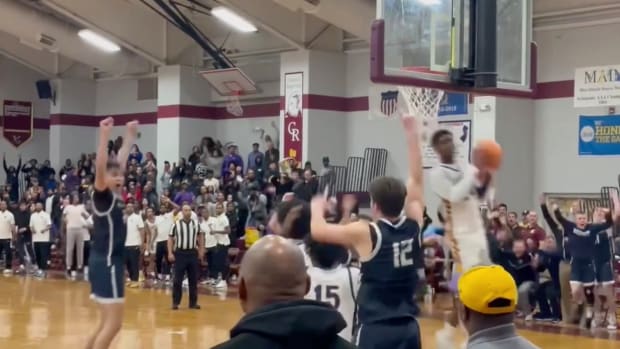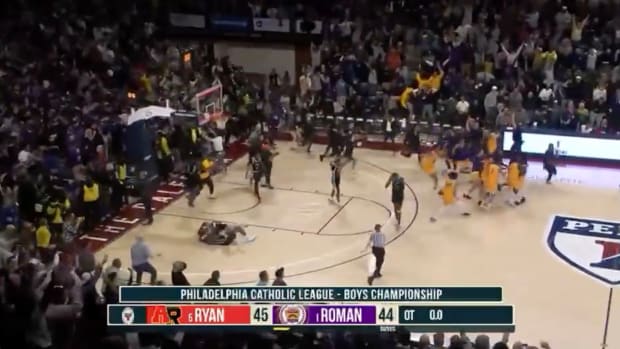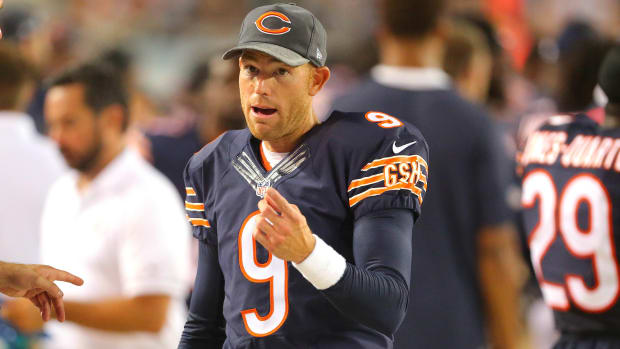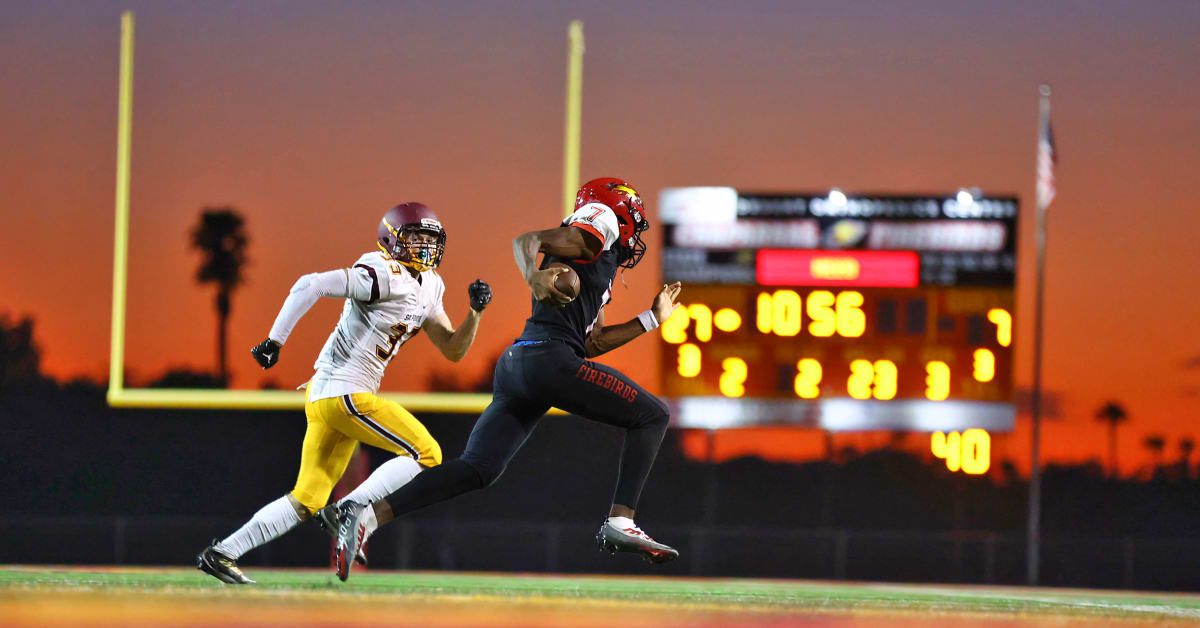
Crusaders and Vultures and Renegades: ‘S--- Is Cutthroat’ in the Valley of the Sun
Cedric Jones sees a football program and he wants to paint it black.
“I’m bringing my 20 African Americans to Chaparral, and we’re taking dead aim at Saguaro,” crows Jones, referring to Chaparral High’s cross-Scottsdale rival, the paragon of prep football programs in the Grand Canyon State. “[Chaparral] is 98% white. We just tripled its Black enrollment.”
Quadrupled it, actually; at least within the football program. But no matter. It’s a sunny July morning in Scottsdale, a city bedecked with mansions and Maseratis. With the mercury already teasing triple digits, all three Firebird teams—freshman, JV, varsity—practice in shorts and, occasionally, shirts.

Marcel Jones is proving his worth with the Chaparral freshmen: In four games he’s thrown 15 TD passes and run for five more.
Mark J. Rebilas/Sports Illustrated
Jones’s son, a freshman named Marcel, is a 6'1", 175-pound human trebuchet who can launch a football more than half a football field. The Joneses live in Goodyear, a Phoenix suburb almost an hour west of Chaparral, a public high school (as is almost every school mentioned in this story). Chaparral’s location, Gold Dust Avenue, is as much a pledge as a postal address. This is Marcel’s chosen school. …Or maybe his dad’s.
Cedric Jones coached a youth football team, the Savages, also based in Goodyear, and his former players now constitute roughly half of Chaparral’s freshman squad. He is not just King Richard–ing his own son back and forth across the Valley of the Sun each morning; he’s keeping the band together. This is not a carpool; it’s an armada. And Marcel is not a ringer; he’s the avatar of the most audacious pimp-my-team experiment anyone in the desert can remember. (Which is saying something, as two years ago Hamilton High, a national power located southeast of the city, imported five players from Colorado, all of whom became impact players.)
So, why the Chaparral Firebirds? Why deal with an hour of morning rush-hour traffic to attend a public school? “Coach [Brent] Barnes is the coldest offensive mind in the state,” says Cedric, who explored 11 potential schools for his Savages alums before picking Chaparral. “He’s scoring 40, 50 points a game with future lawyers and dentists. Just think what he’s going to do with my kids.”
Earlier, Jones and a few fellow dads sat on a sideline bench, admiring the panorama. To their left, near the east end zone: Marcel and his freshman crew. At midfield: the varsity and JV—tanned, but paler overall. And at the far end zone, training: a few Arizona Cardinals players, including former first-round pick Isaiah Simmons and four-time Pro Bowler Budda Baker. Beyond the NFL studs, nestled in the crannies of Mummy Mountain: homes whose individual values eclipse $10 million. The entire storyboard in view.
“We’ve been aiming toward this since Marcel was 7,” says Cedric, sweeping an arm toward Chaparral’s Class of 2026. “Watch this.”
Marcel Jones, standing on the 35-yard line, steps up into an imaginary pocket and lets fly from the 40. The ball traces an impressive arc against a blue sky before it lands precisely on the white of the goal line. Sixty yards.
“This team,” Cedric declares. “Never gonna lose.”
In the Sonoran desert, no stranger to wildfires, a prep football inferno rages, blurring the lines between high school and Division I. The booster program at Marcel Jones’s Chaparral High offers a $3,500 donor package that includes a sideline pass and premium parking spot. Saguaro just installed a $300,000 film room, compliments of its own booster club (which has an annual budget of $275,000). Desert Edge High, an upwardly mobile program in Goodyear, has a coaching staff of 19.
The spark that lit this blaze? Open enrollment, in which a student may attend any public high school they choose, regardless of location, space permitting. Open enrollment was adopted in 1994 as a hedge against charter schools, and it has kindled a steady but unremarkable fire for decades.
It was COVID-19, however, that in 2020 swept in, as high winds might do, transforming a two-alarm nuisance into a grab-the-photo-albums-and-run hellscape. The Phoenix Union High School District, which oversees 11 urban—read: primarily non-white—high schools in Arizona’s largest city, limited its members to three games. Suburban districts, meanwhile, opted to play as many as possible. Ultimately, restless Phoenix teens (and their even more restless parents) sought out school districts where titanium facemasks took priority over the cloth variety.

The PUHSD (light blue) has more public schools—and a larger budget—than any other district. And yet it’s been 41 years since a PUHSD football team won a state championship.
Illustration by Laura Angle
Open enrollment exists in more than 40 states, but Arizona’s desert metropolis possesses unique features that propel it beyond traditional prep football bastions in Florida or Texas. All wood burns, but some woods burn faster. Why?
•Proximity. Though Arizona is the nation’s sixth-largest state by area, almost 70% of its population lives in metropolitan Phoenix, the country’s fifth-most populous metro area. If you were to stand on the campus of the aptly named Central High, you would be within 45 minutes of all but two of the largest schools—the 6A programs—in the state. For the majority of gridders who have a full tank of gas and college aspirations: Take your pick of teams.
•Rapid population growth. Metro Phoenix’s citizenry has jumped 500% in the past half century. Of its 33 6A schools, 27 (82%) did not exist 50 years ago. Your parents did not attend your high school—and they probably grew up in the Midwest or California, anyway. Hence, the gravitational pull of a community is often negligible.
•An inordinately high number of retired pro athletes (and their children), which translates into an infusion of trainers, personal coaches, high school coaches and blue-chip progeny, all of whom stoke the embers of the pigskin industrial complex.
•Year-round favorable weather—and year-round permission, via the Arizona Interscholastic Association (AIA)—to hold organized practices. The climate, in both senses of the term, invites a plethora of offseason events, such as seven-on-seven passing leagues, which are staged as often as school dances.
Open enrollment was created to emancipate students—especially those from under-resourced communities—from the academic limitations of a school district. Its existence has led to the development of magnet programs for exceptional and/or highly motivated students in aerospace, biosciences, coding and so on. But there’s been a corollary outcome: an unregulated proliferation of football magnet programs for outstanding players. At Saguaro, more than 70% of the varsity team lives out of district, including one starter who commutes from Maricopa, nestled between two Indian reservations, 40 miles south.
And what’s wrong with that? “Why is it so taboo that kids transfer to play sports?” asks Charlie Ragle, who as the coach at Chaparral from 2007 through ’11 led the Firebirds to three state championships (and who this season took over at Idaho State). “We don’t begrudge a talented kid in the fine arts or the sciences for doing that.”
The upshot of that approach: Today, four upwardly suburban institutions—Chaparral and Saguaro in Scottsdale; Chandler and Hamilton in Chandler—occupy Arizona’s high school football summit, having combined for 21 state titles since 2009 at different levels. (This is the first season all four are competing in 6A.) “Those four campuses possess 90% of the top-tier talent in the state,” says William Chipley, the coach at Cesar Chavez High, which has unwillingly served as a feeder program to all four in recent years.
Among the Firebirds and Sabercats in Scottsdale, and the Wolves and Huskies in Chandler (where they’re 3.8 miles apart on Arizona Avenue), there’s a Game Of Thrones vibe. Winter is always coming. Survival—or a spot in the eight-team Open Division playoff—is predicated on the same insatiable appetite for conquest that drives House Targaryen. (And Catholic schools, but that’s another story.) So, where is any program’s line of scrimmage between a drive to succeed and a propensity to exceed? Saguaro had been holding practice from 7 to 9 a.m., bleeding into the daily academic schedule, until the Scottsdale Unified School District put the kibosh on it this year. In late July, Chaparral staged an elaborate freshman signing-day ceremony, replete with flame machines. Then the Firebirds bused two hours north to Flagstaff for a three-day camp, where they practiced four times per day, plus film study.
Under center at Chandler is Dylan Raiola, the nation’s No. 1 overall recruit in the Class of 2024, according to 247Sports. Raiola, who was playing in Texas a year ago, succeeds Blaine Hipa, who had transferred to Chandler from his home in Hawaii.
Behind these manifold machinations are two guiding principles to keep in mind as you plow through this story: 1) The aforementioned power programs would rarely sniff even a state semifinal if confined to playing kids from their own zip codes, and 2) as Gene Nudo, a youth football coach in Scottsdale, says: “Rich people don’t like finishing second.”
In April 2021, one dozen names populated the Chavez High varsity roster. Twelve players. Total. William Chipley, who was about to be named head coach after six years with the program, wondered whether he had a football team or a jury.
“It was tough,” says Chipley, a soft-spoken native of Yonkers, N.Y., who has a genuine way of inspiring trust. “We’d lost 24 kids off our 2019 team.”
Chavez is located in Laveen, just eight miles southwest of downtown Phoenix. Directly east is South Phoenix, the most impoverished urban area in Arizona and home to many Chavez students. Among 6A programs, Chavez may have the most impoverished student body in metropolitan Phoenix. The school’s enrollment is 87% Hispanic or Black, the team 100% so.
At the same time, the campus is modern and sits in the shadows of the scenic South Mountain Park and Preserve. The Arizona Republic just named its stadium the best place in the state to watch a game. And historically that team has been dominant. Between 2017 and ’20, Chavez’s freshmen won 26 consecutive games. The Champions buried people. After an eight-point loss at Hamilton in ’17, they won their final six contests by a combined 331–0 score. The ’19 frosh squad (9–0) won by an average margin of 41 points. “That was like a movie,” says Micah Boozer, a third-string running back on that team who is now Chavez’s starting tailback.
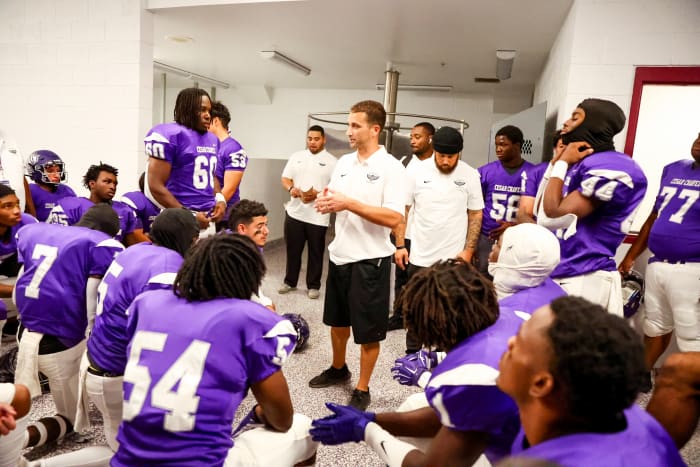
“It was tough,” Chipley (center, in white) says of his 2020 team. “We’d lost 24 kids.”
Mark J. Rebilas/Sports Illustrated
Then, though, came the pandemic and a mass exodus. The PUHSD, which oversees Chavez, exercised extreme COVID-19 caution while suburban districts were far more lax; and Chavez parents such as Frank Bal, whose son was a freshman starter, grew anxious. Then irate. “I understand COVID,” says Bal. “It’s my kid; I’ll sign a waiver [for him to play].”
Another parent, who goes by Doobie and whose son played, too, on that 2019 Chavez freshman team, describes how his kid was “sitting in his bedroom all day, hanging black sheets on his window. He was depressed, and there was no promise from the district that ’21 would be any different.”
Bal and Doobie had together launched Laveen/South Phoenix’s local youth team in 2017, and they’d helped coach Chavez’s freshman squad, their homes turning into flophouses for indigent youngsters in search of a full refrigerator or respite from whatever chaos their own homes harbored. And yet, despite those connections and a tight friendship with Chipley, Bal and Doobie allowed and/or encouraged their sons to bolt to Peoria Centennial High for ’21. A “47-minute drive,” Doobie says. In total, five Chavez players bounced to Centennial, where each was compelled to sit out the requisite five games that in-state transfers face (unless they’re able to demonstrate hardship; incoming out-of-district freshmen are not considered transfers).
The past two years have flooded Bal and Doobie with regret, anger and resignation. “We built Chavez,” says Bal. “It was ready to roll. Phoenix Union district, they don’t get it. S--- is cutthroat.”
“I used to tell moms to keep their kids at Chavez,” says Doobie. “But after 2020, I tell them: ‘Don’t ask me.’”
Last year’s Open Division state championship game between Chandler and Saguaro featured seven former Chavez players. Bal and Doobie no longer coach at Chavez.
Varsity letter jackets just don’t cut it any longer. Players—and their parents—covet scholarship offers. Sure, they yearn to win championships, but they don’t particularly care where. Or with whom.
“We have a kid on our roster,” says Shon Scott, an assistant at Phoenix South Mountain High. “This is his third school.”
Players, parroting what they hear from the adults, talk about putting plays on film as opposed to winning. About maintaining my grades as opposed to education. A championship would be nice, but even better is the day when you’re able to tweet “Blessed to receive an offer from X.”
A Dorothy Complex grips parents and players, who believe D-I offers lie somewhere over the rainbow, or at least at some mega-program a half-hour’s drive away on Phoenix’s modern freeway network. Provided you can get on the field.
Lashown “L-Train” Ealim and Birdie Holloway, a pair of 260-plus-pound linemen, started on that undefeated 2019 Chavez freshman team. The following spring, L-Train and Birdie transferred to Chandler High—or “the University of Chandler,” as one coach calls it—25 miles to the east. In August the pair appeared at a football media day, the latest de rigueur feature of elite public school programs. How did they sell their parents on the idea of uprooting? “Our parents had to sell us,” they say. (L-Train and Birdie first visited Saguaro, “but they told us we probably wouldn’t play much before senior year,” says Birdie. “My ears weren’t listening to that.”)
Commitment still matters. It’s just that those bonds are exceedingly fragile. It’s all become so … transactional. At Centennial High, Austin Glimpse, a 6'5" quarterback with college offers, lost his starting job to a transfer student before his senior season. Glimpse has since departed for neighboring Sunrise Mountain High—all the more awkward as his mom happened to be the president of Centennial’s booster club.
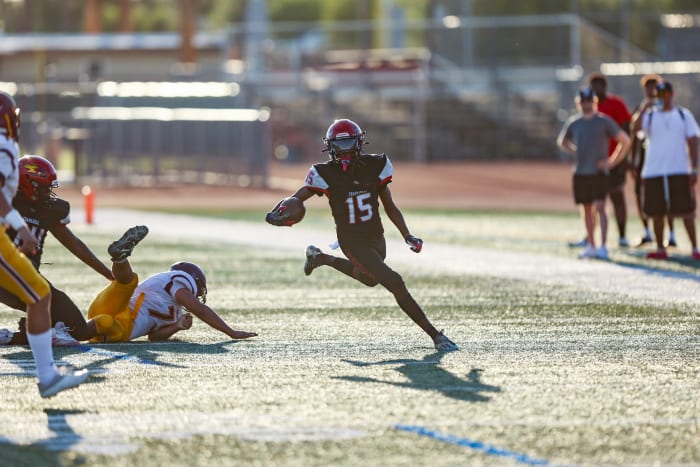
Among Cedric Jones’s imports: Anthony Coleman, a lightning-fast returnman/corner whose daily commute has paid off for Chaparral with five total return TDs.
Mark J. Rebilas/Sports Illustrated
If open enrollment is the oxygen fueling the fire, then Mom and Dad are just more accelerants. “Parents can be your greatest ally or your worst enemy,” says Chris Somerville, president of Saguaro’s booster club.
“Every parent thinks his kid has Division I talent,” says Bal, whose son actually does. “They can be a nightmare.”
Then there’s every boomer’s favorite punching bags: social media and LeBron. “Social media is insanity,” says Ragle, and most coaches agree. Twitter is Humblebrag Junction. “All I see is Blessed to receive an offer here, blessed to receive an offer there,” says Scott, the South Mountain assistant. “Damn, son. Pick a school!”
As for King James: At least four different sources for this story pointed to The Decision as a watershed moment that reverberates to this day. “This generation of kids, they saw LeBron take his talents to Miami,” says Oregon offensive coordinator Kenny Dillingham, a Chaparral alum. “They wanna be on a super team.”
Back at Chaparral, Cedric Jones’s crew of dads are cutting it up. Brandon Williams, a former linebacker at North Alabama, mentions that he pulled his son out of Kellis High, where he’d been the freshman QB1 last season, to play in the Firebirds’ secondary. That’s where he’ll more likely play in college, after all.
Where’s Kellis? “Exactly!” Williams emotes.
Besides his own son, Williams and his wife are boarding three other sophomores on the Firebirds varsity, hailing from Michigan, California and New Jersey. “Those boys are all single-mom kids that I had on my youth team but had to move away for different reasons,” says Williams, who lives 40 minutes away, in Glendale. “I want them to have a better shot at college.”
Another dad, Jessie Colter, took the mother of his son to court in order to facilitate the child’s Chaparral matriculation. Mom wanted the young man to stay close to home, in South Phoenix, attending Chavez or South Mountain. They compromised. “We changed the custody agreement so that he lives with her [in South Phoenix] full-time,” says Colter, “but he gets to attend Chaparral.”
And then there’s the parent from Goodyear, we’ll call him B, who recalls that back in March, before Cedric Jones’s freshman crew had decided upon a school, he was fielding calls from various interested parties. “Chaparral phoned and asked, ‘What will it take?’” he says. “I said, ‘It’s a long drive. We could use a little help on the gas.’”
What happened? B glares. “They helped us out.”
So, Cedric: How come this bloc of talent did not enroll at Desert Edge, a short drive from home? The twins who run that program, Mark and Marcus Carter, have the needle pointed in the right direction and seem to possess a Pied Piper’s touch. “They didn’t respect us,” says Jones of his youth team. “We changed our name from the Savages to Desert Elite. DE. What do you think that’s about?”
Aligning yourselves with Desert Edge? Cedric shoots back a look as if you may just be catching on. And … nothing? “They didn’t even give us money for mouthpieces or shoulder pads,” he says. (Asked about Cedric Jones, the Carter twins roll their eyes from Yuma to Kingman. “I’m not about to tell a 14 year-old, ‘You come here, by junior year you’ll be the starter,’” says Mark Carter.)
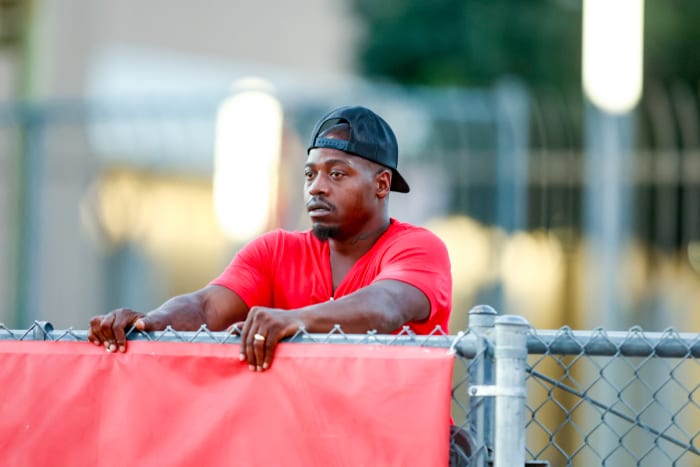
Cedric Jones says he explored 11 potential schools for his Savages alums before picking Chaparral.
Mark J. Rebilas/Sports Illustrated
Meanwhile, alone at the top of the north bleachers, sits another dad. Rob Mangini is watching his son, Max, a 5'11" freshman who lives in-district and hopes to play quarterback. In three previous seasons, albeit in flag football, Max’s teams never lost a game with him under center. He’s currently third string. “I’ve told Max his job is to be a good teammate,” Rob says. “Max may be getting some life lessons earlier than I expected.”
Mangini understands the irony. He’s a well-off white father from north Scottsdale. Max is attending college, with or without a football scholarship. Marcel Jones is on a different path. Cedric Jones remembers Chaparral’s freshman coach, Jason Hersh (who’s also a financial planner for Merrill Lynch), telling him, “I don’t see color.” Says Jones: “I told him, ‘You’re a millionaire. You can afford not to.’”
Rob Mangini is not your typical stage dad. He knows how much an athlete’s landscape can be altered in one year. In 1989, Rob was the Arizona junior state champion in golf. He accepted a scholarship to Arizona State, where he met his freshman roommate: Phil Mickelson. “I’ve told Max to embrace the challenge,” Rob says. “And Max has told me he doesn’t want to leave.”
In 2021, William Chipley, in addition to his coaching duties, served as Chavez’s offensive and defensive coordinator. Of course, many of his kids were playing both ways, too. During practice, Chipley and his assistants stood in on the scout team. At lunch hour, the rookie head coach canvassed the cafeteria for bodies. “I was recruiting the pizza line,” says Chipley, who also teaches five health classes daily. “‘Hey, have you thought of playing football?’”
Meanwhile, Chipley’s 12 angry young men wondered whether there’d be a season. “It’s no fun practicing against air,” says Boozer, the running back.
Jose Rivera, a receiver/cornerback whose “El Chapo” nickname alludes, more than anything else, to his leadership qualities, recalls hearing from former teammates who’d transferred away. “They were texting me every day, like, ‘Bro, we can find a place for you here,’” El Chapo says. “This is home. I don’t wanna go nowhere. The way I see it, they were shying away from adversity.”
El Chapo is a first-generation Mexican American with a 4.7 GPA. But when it’s suggested that he practically has his choice of colleges, El Chapo replies, “I don’t know if I’ve got enough plays on film yet.”
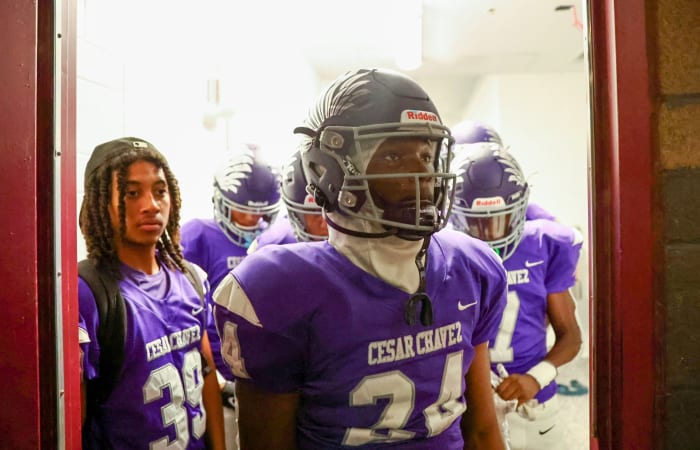
Says Boozer (24) of Chavez’s dwindling numbers: “It’s no fun practicing against air.”
Mark J. Rebilas/Sports Illustrated
By July, Chipley’s Chavez roster had 22 names. He reassured his players that they’d overcome this crisis if they just stuck together. He posted a sign in the locker room that became the season’s mantra: PROVE THEM WRONG. Then, on the first day of classes, a student walked into Chipley’s classroom. A junior who had never played football before.
“Coach, would it be O.K. if I joined the football team?” asked a young man named Zachary Cook.
Chipley looked up and smiled. “Absolutely.”
Cook is 6'7", 270 pounds.
It is ironic, looking back, to hear Charlie Ragle identify Chaparral High’s No. 1 problem when he became coach, 15 years ago: “We were losing too many kids to the private schools. We needed to keep our kids around.”
The kids, or their parents? Chaparral’s student parking lot resembles a BMW showroom. “Hey, man, there’s money in this program,” Ragle, whose brazen enthusiasm was a perfect counterbalance to Scottsdale’s mannered pretensions, says he remembers telling himself. “This is a place we could win.”
With such deep pockets backing him, Ragle installed FieldTurf at Chaparral, a first in the Valley of the Sun—then he rechristened the local youth team as the Firebirds and insisted that they use the pristine new venue on Saturday mornings, while paying a usage fee.
Early on, Ragle went out to lunch with Jeff Stone, who ran a construction company and whose son Spencer was a sophomore QB at Brophy Prep, and the coach walked away with a three-fer: Spencer became Chaparral’s varsity QB1; Jeff, who’d played at Miami of Ohio, was named the school’s running backs coach; and Ragle found a construction company to build the Firebirds’ fieldhouse at minimal cost. Ultimately, Ragle’s faith in the family Stone was rewarded, as Spencer led the state in passing as a junior and senior. (Stone’s daughter, Emma, meanwhile, was appearing on hundreds of screens nationwide in her motion picture debut, Superbad. “A dizzying time to be a parent,” says Jeff Stone.)
When Ragle says he “surrounded myself with winners,” he ain’t blowing smoke. David Ziegler was not yet 30 when Ragle got him hired as a guidance counselor, in 2007. Today Ziegler’s the GM of the Las Vegas Raiders. Darren Mougey was just out of college when Ragle made him an offensive assistant, in ’11. Now he’s the assistant GM of the Denver Broncos. And Kenny Dillingham was a Chaparral senior in ’07, playing for Ragle, when he tore his ACL and pivoted to helping out as an assistant. Now he’s the offensive coordinator at Oregon. (Dillingham remembers that early on Ragle was “asking us why people make bad decisions. What tempts them. And I said, ‘You have to decide whether the juice is worth the squeeze.’ He looked at me differently after that.”)
Those were dizzying days for all, as the Firebirds won the state championship every season from 2009 through ’11. “We did some innovative stuff,” says Ragle. “We moved workouts to 5:30 a.m. We hired a deejay for our home games”—a young MC named Just Chilly, whom you’ll meet in a bit. “As we won, we noticed the community changing.”
Indeed. Money poured into the booster program. Firebirds parents became notorious for chartering buses to road games, fueling up on Fireball en route. Future NFL players—All-Pro left tackle Taylor Lewan, from Cactus Shadows High; defensive back Deveron Carr, from Chavez—began arriving at Gold Dust Avenue just before senior year to suit up for Ragle.
Ragle was young and brash and flat-out fun, but some in the coaching fraternity never made it past f-u. “They said we recruited,” says Ragle. “Hey, we recruited on Friday nights.”
When coach Jason Mohns led Saguaro onto the field at Sun Devil Stadium last December for the Open Division state final against Chandler, his hyper-organized brain was likely too focused on the game to contemplate that this is where it all began. Not his career, but him. Between 1977 and ’80, Mohns’s father, Greg, was an assistant under Arizona State coach Frank Kush. A little further down the sideline, his mom, Amy Homco, pranced as a cheerleader.
“I know it sounds taboo now,” Mohns says of this coach-cheerleader hookup, “but my dad was still only in his 20s.”
Saguaro and Chandler have been the state’s juggernauts the past decade, competing on a higher plateau than all other schools (and on different classification levels from each other until 2019). And at Saguaro, the program’s success recruits itself. Georgia cornerback Kelee Ringo, a prospective first-round pick in next spring’s NFL draft, years ago moved from Tacoma to play for Mohns. “Jason Mohns doesn’t have to recruit,” says Conrad Hamilton, the coach at Desert Mountain, in Scottsdale (and yet another ex-NFL player in the desert). “He’s turning away kids.”
“I want kids who want to get offers,” says Mohns. “It shows me that they love football. And I’m very up-front with them that nothing is promised.”
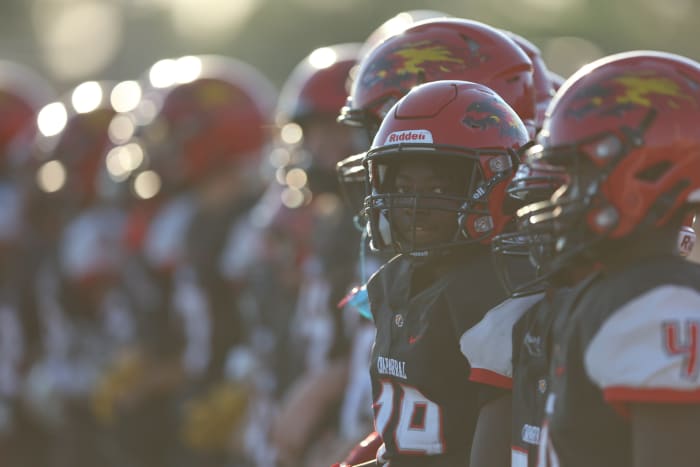
Chaparral’s freshman Firebirds are 4–0 this season, with a 39-point average margin of victory.
Mark J. Rebilas/Sports Illustrated
Mohns may not recruit. He is definitely savvy. In 2007, before he was even an assistant at Saguaro, he launched a youth tackle football program. That squad’s name was inspired by the CFL team where his father was at the time the assistant GM, the Toronto Argonauts, and the younger Mohn’s Argonauts became the archetype for youth football (or feeder) teams in the Valley, exploding tradition.
“When I was a kid, and you signed up for Pop Warner, you had to bring a phone or electric bill to prove your home address,” says Mohns. “Your team was kids from your neighborhood.” Now, many of the top high school programs are associated—though not officially—with one or more feeder teams in their area, and those feeder teams operate as well in an open-enrollment ecosystem. The advantages are manifold. Kids 8 to 14, from anywhere in the Valley, are able to play within a program that often mirrors its high school big brother. Grooming is a third-rail term these days, but that’s often what is transpiring.
“On any given morning, 100 kids in the Valley are being driven to high school by their [former] youth coaches,” says Hamilton defensive coordinator Tim Dougherty. “Youth football is the f---in’ elephant in the room.”
Meanwhile, a coach from the big brother high school is often moonlighting as a staffer for the feeder team. Can it be just a coincidence that the program director for the Argonauts, Andy Johnson, is a Saguaro assistant? Or that Chaparral’s freshman coach, Hersh, also leads the 10-and-unders for the Scottsdale Firebirds?
The AIA’s Rule 15.12.4.8 states that “high school coaches … may not attend youth sports … for purposes of evaluating and recruiting prospective talent.” Yet, while anyone can see that Johson’s and Hersh’s dual roles are de facto violations, the AIA enforces this about as vigilantly as Phoenix police do HOV-lane infractions. Which is to say that it does not.
“We are a member-driven governing body first,” says AIA associate executive director Joe Paddock. “We are not an investigative body.” And when it is suggested that maybe the AIA should devote more vigor—and funding—to the latter? Paddock mimics the shrug emoji.
Mark and Marcus Carter have been a package deal since before birth. Once the twins shared a womb. Today they share an office and a job: co-head coaches at Desert Edge, an idyllic suburban high school the likes of which once dominated the CW network dramas. A Black coach has never won a state football championship in Arizona. “The first tweet we sent out when we took this job,” says Mark, “was ‘challenge accepted.’”
In 2016, before this job, the Carters were tapped to revive the carcass that was football at South Mountain High, situated in the poorest section of town. The Jaguars represent the last Phoenix Union school to play for a state title, in 1993—but in the half-decade before Mark and Marcus arrived, South was a moribund 3-47. “There were 19 kids,” says Marcus. “We didn’t have a booster program. We didn’t have much of anything.”
Apathy and indigence. South’s football program mirrored the surrounding South Phoenix area. Challenges abounded. The Carters claim that during freshman games players would switch out of their uniforms at halftime—jerseys, pants, pads, helmets—so the other half of the team could play.
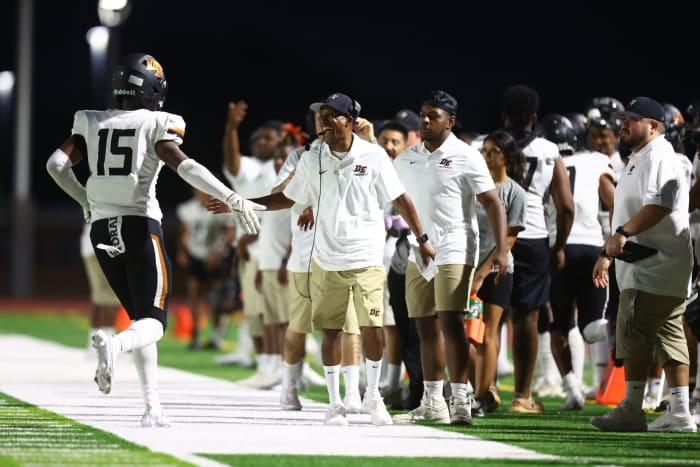
Mark Carter (center, high-fiving) and his brother, Marcus (not pictured), know that a Black coach has never won a state title in Arizona. Their response: “Challenge accepted.”
Mark J. Rebilas/Sports Illustrated
Mark and Marcus (who’s two minutes younger) understood they’d been handed a lousy opportunity; they also knew it might be the only one they’d receive. So they worked it. “What we are is good marketers,” says Marcus, who, like his twin, did not play high school football. “We started a youth football team. We preached ‘CTC.’ Change the Culture.”
The Carters were crusaders, imploring parents and players to stick around. And they were persuasive. Each season the Jaguars improved, from 1–10 in 2016 to 7–3 in ’19. However, because of the AIA’s arcane ranking method, that ’19 team was not one of the 16 schools invited to the 5A playoffs (while three teams with .500-or-below records were). Mark and Marcus Carter are not the type who need to be told twice how a glass ceiling works.
Then the position at Desert Edge came open. Mark and Marcus applied and were hired in 2020.
South Mountain, to fill their void, hired former Philadelphia Eagles linebacker Byron Evans, an alum. But even a personage with Evans’s pedigree is fighting a losing battle in the offers war. “We’ve had a mass exodus of players to Desert Edge,” says Scott.
Even with an ex-NFL player coaching? “It’s 2022,” Cedric Jones crows. “Nobody knows who Byron Evans is any more.”
Considering how Chavez’s 2021 season began, a 5–5 record was a redoubtable triumph. Prior to Coach Chipley’s hiring, all four quarterbacks had transferred out. However, in a gridiron application of Fick’s First Law of Diffusion, a backup from Tempe Marcos De Niza High soon arrived to fill the vacancy.
Still, every day tended toward an audible. “You never know who’s going to show up for practice,” says Chipley, whose roster topped out in the 30s, “and if you apply the same discipline you might somewhere else, you might never see them again.”
Handcuffed by his players’ inexperience, Chipley employed the same base defense all year. Zachary Cook, the 6’7” neophyte tackle and defensive end, played soft early in the season and did not understand the rules, but the coaches gleaned a sliver of potential. A .500 finish, given all of this, was borderline miraculous.
While a number of Chavez emigres were showing out—and putting plays on film—at suburban schools, Chavez itself entered 2022 with hope. And with a bona fide stud: a lanky, swift rising junior named Kezion Dia-Johnson. “Kez was a revelation and our MVP,” Chipley says. “Our best weapon on offense: he played wideout, running back, we even had a Wildcat package for him. He returned all kicks, played corner. He never left the field.”
Then came the offseason.
On Jan. 15, Dia-Johnson participated in a 7-on-7 passing league tournament where Frank Bal, the former Chavez assistant, says he observed Mark Carter speaking to the Swiss Army–knife talent for 15 minutes—an AIA no-no. Bal texted Chipley, and two days later the coach texted his wondrous playmaker: Did the Carters contact you? “Yes,” Dia-Johnson replied, according to Chipley, adding that Coach Marcus had asked the player to point out his parents. “[He] told me I wasn’t going to get any offers at Chavez and I needed to enroll at Desert Edge.”
A few words, before we go on, about passing leagues. “That’s where the vultures come out,” says Bal. Passing leagues allow for offseason fraternizing between players from different schools, where talk of super teams is broached. They also create an avenue for one-degree-removed recruiters—trainers, youth coaches, high school track coaches—to whisper in a kid’s (or a mom’s) ear. “My head coach wanted us to put names and numbers on our kids’ passing league jerseys,” says Scott, the South Mountain assistant. “I said: ‘Coach, that’s the quickest way to get your kids recruited [away]. You might as well include their cell numbers.’”
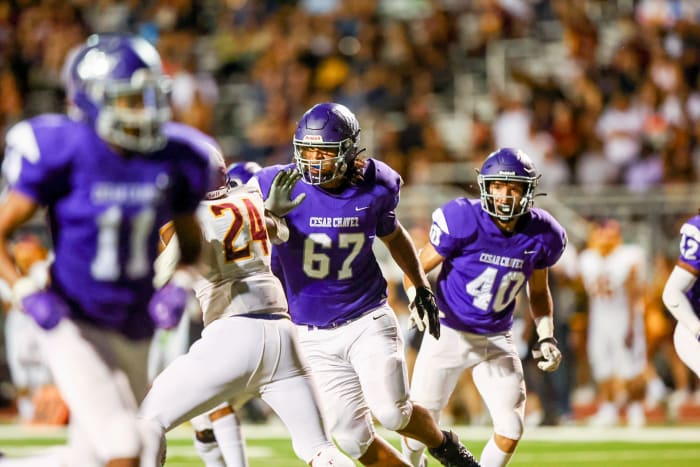
Last summer a 6’ 7”, 270-pound student approached Chipley in class and asked:“Coach, would it be O.K. if I joined the football team?” Enter Zachary Cook (67).
Mark J. Rebilas/Sports Illustrated
Back to the Carter twins and Kezion Dia-Johnson. Two weeks after that passing league event, Dia-Johnson withdrew from Chavez and enrolled at Desert Edge. A few days later, one of Chipley’s players was forwarded a SnapChat image: Kez, Aundre Gibson—Desert Edge’s top D-I recruit for the Class of 2024—and the Carter twins, with the caption, “We got your favorite wide receiver.” (Separately, in a text, Mark Carter, who lives less than a mile from the Chavez campus, told his nephew, a Desert Edge student, that he would provide another potential Chavez transfer with transportation to Desert Edge if that student were to enroll, and Carter shared with his nephew a link to open enrollment. Ultimately, the student opted to stay put at Chavez.)
In the end, Chipley and his athletic director, Lenny Doerfler, sent a detailed report of the incident to the AIA … which forwarded it to Desert Edge AD Jason Linn, with the implied understanding that Linn should police his own house.
“We are not an investigative body or an enforcement body,” reiterates Paddock, at the AIA, “unless our executive board decides to look into a case.”
That board, in this instance, issued a toothless one-year warning, burying the reprimand in the minutes of its February meeting. The courting of Dia-Johnson went unreported; Chavez officials were never even informed of the board’s warning.
Linn wrote a letter of reprimand to his co-coaches, who categorically denied all allegations. No further penalty was forthcoming. Once again, Chavez had lost its top player to a suburban school promising more opportunities.
“All I can tell you is this,” says Desert Edge’s Marcus Carter. “Kez hasn’t even played a game here yet and he’s already received six [college] offers.”
At Desert Edge, Kezion Dia-Johnson will find a roster of Black kids, white kids, Asian kids, Latino kids. “We have what the world looks like,” says Marcus. “Our middle linebacker hangs out with our kicker.”
The program is player-friendly. The Scorpions bring their sound system with them on the road, set it up at the 40 during warm-ups and turn it up. Kids suggest plays during games. You wanna celebrate that touchdown or big hit, go right ahead. “We’re not here to control kids,” says Mark. “It’s more important to us to let our players express themselves than to worry about your feelings.”
It is suggested to the Carters that they’re modeling Desert Edge after The U-era Miami. Mark Carter smiles. “I’ve been telling people for a while that when we make it to the state championship,” he says, “we’re all showing up in combat fatigues.”
It’s dusk on the last Saturday of June when 800-plus male teens convene at Copper Sky Regional Park in Maricopa, 20 miles from anywhere—an unusual place to find the richest collection of Arizona prep talent you’ll see on one patch of grass all year. The event is called Just Chilly’s Flight Club: a 32-team invitational 7-on-7 tournament. JCFC has no affiliation to the AIA or, officially, to any program. And, because it’s a dead period, college recruiters are forbidden. Just high school players and coaches and anyone who cares to watch.
So why is everyone here? Because it’s a Just Chilly jam. And Just Chilly, as any desert baller with a social media presence knows, is the s---.
Chilly prefers not to divulge his birth name or his age, though he looks in his early 30s. His wardrobe is vintage hip-hop, which suits the former morning radio deejay. (His stint at Chaparral ended long ago.) Chilly is cryptic about his past, too, though he allows that he was a decent high school linebacker in Massachusetts.
Whatever his provenance, Just Chilly is the truth to Valley footballers. Thus, coaches and, yes, college recruiters pay fealty to him. Yo, Chilly’s my guy is the near-Pavlovian refrain whenever you mention him. Jordan Somerville, a recruiting analyst at Oregon, for example, names Chilly when asked who’s the No. 1 talent evaluator in Arizona.
JCFC began in the spring of 2020 as the sobering isolation of the pandemic kicked in and Chilly received a plethora of texts from players and parents. They were bored. They were restless. They were depressed. “So I got this idea to organize an informal sevens league at a park,” Chilly says. “But I laid down these rules: Just two teams per day. No cellphones.” And because of COVID-19 restrictions on gatherings: “No spectators.”

Just Chilly started his Flight Club as a COVID-19 work-around; it’s since turned into a 32-team invitational 7-on-7 tournament.
Mark J. Rebilas/Sports Illustrated
Flight Club, as in Fight Club. Keep it on the down-low. “It went off without a hitch for nine weeks,” Chilly recalls. “And then one day the city came and shut me down.”
“I just want to help kids,” says Chilly, who’s earning a degree in education at ASU. And simply for putting on an event of this scope, he deserves props. Most guys his age are overwhelmed throwing a backyard barbecue.
Tonight, in Maricopa, games are spread across seven fields; and with COVID-19 restrictions lifted, coaches, parents and media types schmooze and dish. Hamilton’s quarterback, Roch Cholowsky, is tossing darts to his three-star wideout, Tre Spivey, the son of former Diamondbacks second baseman Junior Spivey. But, as of this evening in June, it’s still unsettled whether Cholowsky will take snaps in the fall. A probable first-round pick as a pitcher in the 2023 MLB draft, he is undecided as to whether he’ll suit up this fall. “I’m told there are three families in California willing to move to Hamilton tomorrow if Roch decides not to play,” a plugged-in young reporter says.
So it goes.
The biggest surprise of the night occurs during the Big Man Competition, an NFL-combine-style battery of skill, speed and strength tests. Zachary Cook, who a year earlier had never played organized football, is named MVP. His prize: a comically large golden necklace.
Flight Club does not end until after midnight. Two days later, an assistant at a school already overflowing with talent will shoot Cook a direct message on Twitter. He will decide that the juice is worth the squeeze.
Forty-one years have passed since a public institution from the PUHSD—a city school—last won a state championship. Those Trevor G. Browne High players are grandfathers now. In a town notorious for extended dry stretches, this is a doozy.
Phoenix was then and is now the largest city in Arizona. The PUHSD has more public schools than any other district. It also has a larger budget than any other district. And yet: 41 years. What gives?
Part of the problem is, strangely enough, a lack of representation. In the past 34 years, only one representative from the PUHSD, Dr. Zach Munoz, has served on the AIA’s 10-member executive board, and that was for a two-year stint. “I would abolish open enrollment if I could,” says Munoz, whose stint ended in 2021. “But that proposal would never pass with the way the board is constituted and the members selected.”
The PUHSD ensures its kids a chance to play—the participation fee for football is $2, essentially free—whereas in the ’burbs parents encounter fees that normally run in the neighborhood of $200. Additionally, PUHSD’s schools lack the six-figure booster programs that provide amenities that may entice 15-year-olds or their parents. Like the program at Saguaro, where Somerville says, “We feed our players five times a week—that’s our largest expense.”
For some struggling families, that meal plan alone is enough to ring the register. That and you’re dealing with a different generation of players. “They care about the glitz and the glamor,” says Scott, who coaches at his old school, South Mountain, while also being unapologetically old school. “‘Oh, we got brand new jerseys!’ That’s genuinely what they care about: looking good.”
Urban flight translates into wins for the suburban powerhouses. It also delivers cold, hard cash through something called Average Daily Membership (ADM), the formula by which the state divides up the educational budget per district. Each student at a Phoenix-area high school represents $8,770 of budget money. Every three-star wannabe who transfers out is a budget cut; each one who transfers in is a windfall.
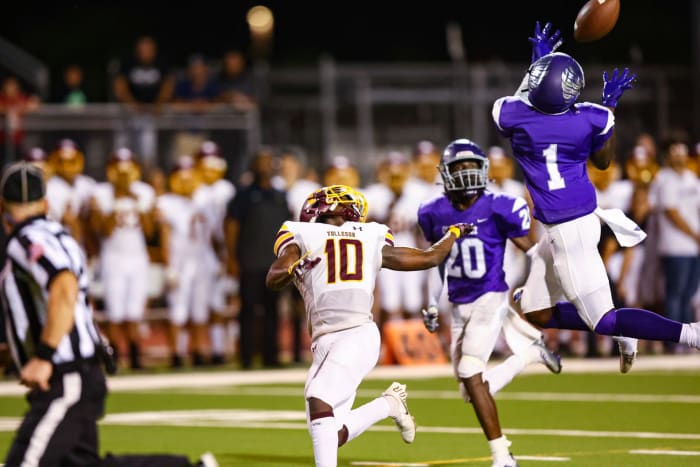
Among those who’ve stuck with Chavez: corner/receiver Antwon Jenkins, here picking off Tolleson High.
Mark J. Rebilas/Sports Illustrated
Which perhaps helps one understand why Mountain Pointe High, in the Tempe Union district, sends a bus each morning to Laveen, just half a mile from Chavez’s front gate. The two schools are 15 miles apart, but those students, just by their ADM values, cover the cost of the transportation. “They’ve got at least seven kids from our district who would be starting for us,” says Chipley.
Responds David Huffine, the athletic director for Tempe Union schools and Charlie Ragle’s old offensive coordinator at Chaparral: “If there’s a group of students from Laveen who want to attend Mountain Pointe, we’ll send a bus.”
Chipley: “Check out the size of those kids at the bus stop. How many of them would be attending Mountain Pointe if they didn’t send the bus?”
It’s the old question: What came first, the chicken or the three-star edge rusher?
Steven Arenas is the coach at Phoenix Carl Hayden High, another campus located in a relatively blighted area. Last fall his Falcons enjoyed their first winning season in 25 years—but then, in late July, Kendre Pride, a 1,100-yard rusher as a sophomore, announced on Twitter that he was transferring to Basha High, one of a number of modern schools sprouting up amids the cacti in the burgeoning East Valley. That’s a 35-mile one-way drive.
“What high school football should be about is teaching values, and we’re getting away from that,” says Arenas. “Here at Carl Hayden we’re trying to build a community.”
But what if that community never extends beyond the football team? Consider Chaparral, which during the 2021–22 academic year employed no Black faculty or administration members. Zero.
Six years ago Chaparral had one: English teacher Tina Lewis, whose husband, Tim, a retired NFL player, was the Firebirds’ head coach. The Lewises authored an after-school tutoring program for Black players, paying faculty $30 an hour out of their own pockets. Many of those same players turned Tina’s classroom into their cafeteria. “A few of the Black football players felt ostracized,” says Tina. “They asked if they could eat lunch in my room, and before long they were there every day.”
A search for community. At relatively urban schools such as South Mountain, Carl Hayden and Chavez, there may be more at stake than playing at Sun Devil Stadium in December. “If I can contribute to keeping 100 kids in a football program and off the street,” Arenas says, “that’s a win for us.”
Says Chipley: “More than 90% of my players don’t have dads in the home.”
“It’s what Byron Evans tells the parents of our kids,” says South Mountain’s Scott, referring to his NFL veteran turned head coach. “‘If you’re looking for championships, I’m not that guy. I’m here to pour my values into your kids’ lives.’ Some of these kids, the only time they get discipline is when they’re around us.”
Max Mangini, ostensibly Chaparral’s third-string freshman quarterback, is running in circles. Literally. Mangini, under the watchful eye of his private passing coach, Jim Rattay, is throwing to a fixed target in the center of a circle as he orbits it. First counter-clockwise, then clockwise.
“Remember what I told you. I wanna see you smile,” says the coach, who at 73 has a fairly monumental résumé: five prep state championships in Arizona and two before that in Ohio, across a 40-year coaching career. He also has a reputation as a QB whisperer. He took a six-foot-nothing kid at Phoenix Christian High and turned him into a two-time D-I passing leader, at Louisiana Tech, and later an eight-year NFL backup. That would be his son, Tim.
“There’s so much more to playing the position, mmm hmm,” says Jim Rattay, “than being able to complete an out route to the wide side of the field.”
Max is finding it easier to toss a 10-yard pass against his body while circling clockwise than to force a grin. He’s just returned from Chaparral’s camp in Flagstaff, where he garnered no reps at QB and was shifted to corner. Lanky and giraffe-legged, Max is not well-suited for the new position. His dad is beginning to wonder whether the same may be said for the school.
This tutorial arrangement is rife with irony. Rattay was orphaned twice as a child, and here he is working with a player whose father is only too happy to invest in his son’s development. Second, Rattay’s final coaching stop was at Chavez High, where the AIA placed his program on probation and imposed a postseason ban in 2009 and ’10, for allegedly recruiting a player. “They literally walked me off the practice field the day before our final regular-season game,” says Rattay. “We were No. 4 in the state.”

With all the new bodies, Max Mangini (16) seemingly never stood a chance on Chaparral’s freshman QB depth chart. He was moved to cornerback.
Mark J. Rebilas/Sports Illustrated
Rattay’s top player in 2009, sophomore receiver/corner DaVonte’ Neal, then transferred to Chaparral, where he led the Firebirds to a pair of state championships and twice earned Gatorade Player of the Year. (No other Arizona high school player has repeated in the award’s 37-year history.) After his college career at Notre Dame and Arizona fizzled, Neal was employed as a security guard at Chaparral, but in 2017 he quit that job—curiously, at the time—without explanation. Five years later, while he was working as an assistant at Idaho State under his other former high school coach, Charlie Ragle, Neal was arrested and charged with first-degree murder … which he’s alleged to have committed while working the security job at Chaparral.
Relevant how? It was Neal’s success at Chaparral that provided the blueprint for the current infusion of out-of-district players led by Cedric Jones. “DaVonte’ had all the talent in the world, mmm hmm,” says Rattay. “What’s happened is just a tragedy.”
Rattay is sanguine as he assesses the Arizona high school landscape. He points out that Neal actually departed Chaparral after the fall semester of his senior season and finished his high school academics at Central High. Rattay claims to have been told “face to face” by a PUHSD assistant superintendent that “we had to have someone take DaVonte’s tests and SAT for him.” (That administrator declined to comment for this story.) He acknowledges the pandemic of 2020 but does not blame it solely for the pandemic of unrestrained recruiting and cheating taking place directly under the nose of the AIA, with almost no repercussions.
“What’s happening is that there’s zero enforcement,” says Rattay, who still finds it comical that his own program was put on probation when so many others have avoided that fate. “And when there’s no enforcement, there’s no rules.”
On June 29, Hamilton assistant Tim Dougherty sent this DM to Chavez’s Zachary Cook:
Zach, I was impressed with you at the Big Man competition this past weekend. You are way ahead of where our defensive linemen [sic] from Hamilton HS, Deuce Davis was as a sophomore and after 1 year at the varsity level, he had multiple offers and was selected as Gatorade Defensive Player of the Year. The coach who ran the Big Man [competition at Flight Club] is my DL coach … and one of the best DL coaches in the state.
According to Rule 15.12.4.6 of the AIA by-laws: “A high school coach may not initiate contact with a student at a junior high/middle school or other high school, or the parents of that student, about attendance at the school.”
Cook showed the DM to his Chavez coach and AD, Chipley and Doerfler, who this time decided to catfish the encroaching assistant. They replied: “Wow, thanks for reaching out,” unspooling more rope for Dougherty to hang himself. And he did, replying:
Thanks! I was impressed with you at the competition. Our defense has ranked #1 in AZ for the last 3 years. It’s a fun defense to play in with a lot of movement and pressures. Deuce Davis went from an unknown to Gatorade Defensive Player of the Year.
The Chavez brass had learned a lesson from the Kezion Dia-Johnson episode. Instead of directly contacting the AIA, or Hamilton’s AD, Doerfler used his own account to put Hamilton and all potential poachers on blast, tweeting:
Which polarized the Valley. A surprising—or perhaps not so—number of coaches and parents admonished Doerfler to shut up and worry about his own school.
Nonetheless, on Aug. 11, around the time Jim Rattay lamented the absence of enforcement, the Chandler Unified School District suspended Dougherty for three games. Four days later, the AIA placed Hamilton on a year’s probation for a recruiting violation, prohibiting the Huskies from participating in the postseason. And on Aug. 24, in what might be construed as a preemptive strike to gain favor before an appeals hearing, the CUSD extended Dougherty’s suspension from three games to the entire season (potentially 15 games). Meanwhile, he’d still be expected to coach ’em up for the Huskies’ opener versus Centennial.
Sitting a month later in his classroom on Hamilton’s campus, where he still teaches American government and history, Dougherty feels he has been offered up as a sacrificial lamb to salvage Hamilton’s season. “I’ve been coaching high school football for 42 years,” says Dougherty, who spent 37 of them in Illinois, 16 as an athletic director. “If I wanted to recruit that kid, do you really think I’d be dumb enough to do it directly? I was just trying to [build up his confidence]. And I didn’t know the problems Chavez was having with transfers. If I knew then what I know now, I never would’ve reached out to him.”
Be it poor judgment or an honest mistake, Dougherty, a former walk-on at ASU (playing under Greg Mohns on defense) and an enshrinee in the Illinois High School Football Hall of Fame, finds himself garnering more attention for an ill-conceived DM than he’s ever received in more than four decades of coaching. And, like the mobile classroom in which he teaches, somewhat untethered to the rest of Hamilton at the moment. A pariah. Until he’d spoken to SI, this coach who has been preaching defense for two-thirds of his life had yet to mount a defense of himself. “I really hope I get to coach football again,” Dougherty says. “But if I don’t …”
He lifts a single-fingered salute to, presumably, the CUSD and AIA.
“I did it for me. I liked it. I was good at it. And I was… really… I was alive.”
–Walter White, on Breaking Bad, confessing to his wife that money was not, ultimately, his primary motivation as a drug lord.
It’s not about the money. Saguaro’s Jason Mohns is the gold standard in the Valley, and his annual coaching stipend is just over $5,000. Granted, when a school’s annual booster budget is 55 times the coach’s stipend, as is the case at Chaparral and Saguaro, you may reasonably wonder about a slush fund. (Chaparral’s booster club prez, Steve Bollinger, insists that’s not the case: “I drive people crazy with how by-the-book I am.”)
At Desert Edge, Marcus Carter, who purchased three drones for use at practice with his own money, says: “I basically am paying to coach, when you break it down on income versus expenditures.”
While a few of the coaches that Sports Illustrated spoke to consider their position a stepping stone (Ragle now earns $205,000 per year at Idaho State), more of them consider it their Rosetta Stone. “I saw the life that my dad lived,” says Mohns, who grew up mostly apart from his father, an itinerant football lifer. “I like that I can take my 4-year-old son out for doughnuts on Friday mornings.”

Why coach? It ain’t always about the money. “I basically am paying to coach,” says Desert Edge’s Marcus Carter.
Mark J. Rebilas/Sports Illustrated
Mohns remembers conversations with Ragle after Ragle had “jumped” from Chaparral to working as a college assistant. “Whenever Charlie would stop by to recruit,” says Mohns, “he’d always say to me, ‘Remember, Jason, it’s good to be king.’” That is: Being the CEO of a top-tier high school program is more fun than being the special teams coach at a Pac-12 school, as Ragle was before this year.
Walter White was a high school teacher, too. But after hours he morphed into Heisenberg. He initially ventured into the dark recesses of the drug world believing that his mastery of chemistry would set him apart. He soon discovered that all of the ancillary duties—fending off the wolves, managing alliances, outsmarting the DEA—occupied as much of his time. And, well, he found that infinitely more stimulating.
“I’m having too much fun here,” says Mohns.
They all are. There’s the game on the field. But the game off the field—that’s where empires are won and lost. That’s where high school coaches become Heisenbergs.
You can’t win if you don’t keep the talent. You can’t keep the talent if you don’t win.
The paradox is obvious. Less obvious is the tug of war between opportunity and community. If the players at Chavez or South Mountain simply stayed put, they’d be the winning programs. There would be no need to flee to winning schools in the suburbs. But a parent thinks only in terms of their own child’s future. “I don’t blame any parent for doing what he thinks is best for his own kid,” says Chavez’s Chipley. “I just think we can provide those opportunities for him, too, if we all stay here.”
It’s July and Just Chilly is explaining how in the summer of 2019 he predicted that the then-incoming class of Chavez freshmen would be a top-four team in Arizona as seniors “if they can stick together.”
The conversation moves on to why Chilly dropped his radio persona for a career as a teacher. “Terrestrial radio has decided that they don’t care enough about the community and… .” Chilly stops. He notices the sidelong glance directed back at him. Drops his chin. With a sigh he pulls off his baseball cap and runs a hand through his thick, dark mane.
“Of course I want the kids to stay in their own communities,” he says. “But … hey, if you want to fix it, WIN!”
Fast-forward to a Friday night in late August. At Chavez, nearly 40 varsity players are trying on their game uniforms for the first time, for team pictures. Parents and coaches affix helmet decals. The teens pose and preen, clearly hyped for the season that awaits them.
It was Shon Scott, at South Mountain, who suggested in June that the fastest way for a tectonic shift to occur—for inner-city schools to curb the exodus of players to the suburbs—would be the emergence of a transcendent talent. “All it takes is one player staying home to turn the tide,” Scott said.
As Chipley applies a decal to a helmet, Zachary Cook walks past. His jersey number, 67, is a nod to his height. Around his neck Cook has draped the gargantuan gold-plated necklace he won back in June.
All it takes is one.
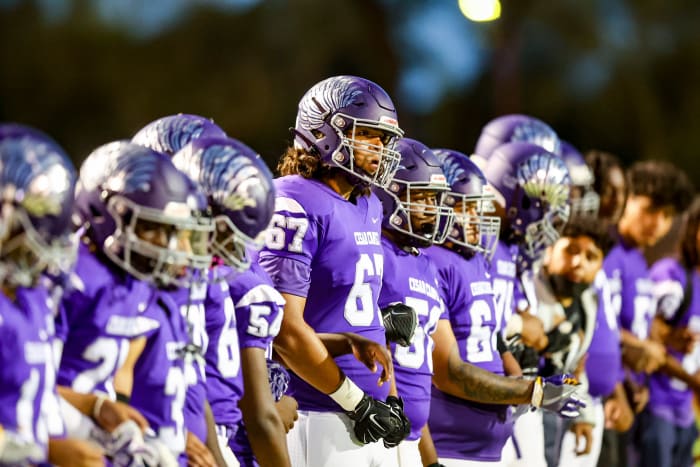
Cook, with a limited understanding of the rules, was slow to fit in at tackle and defensive end last year. That’s turned around in 2022.
Mark J. Rebilas/Sports Illustrated
Fast-forward one month:
Chaparral’s freshmen won their opener in August, 55–28, as Marcel Jones ran for four touchdowns and passed for another. After each score, Cedric Jones proclaimed, “Coming to a Friday”—varsity—“near you!” In the first half of the same contest, Max Mangini, playing cornerback, dislocated his elbow and was lost for the season. Nine days later he transferred to Desert Mountain. The freshman Firebirds are 4–0 with a 39-point average margin of victory. Marcel has thrown 15 TD passes and run for five more. He has yet to appear in the fourth quarter.
Desert Edge is 3–1 and led at halftime of its second game 58–15. Chavez, after winning its first two games, is 2–2. South Mountain, after winning its first two by identical 47–0 scores, is also 2–2.
In a rematch of last December’s Open Division state championship game, Chandler fell behind Saguaro 14–0, then rallied to score 31 consecutive points in a 31–21 win. The Wolves are now 4–0.
Basha is 4–0 and ranked No. 1 in the state, even without Kendre Pride—the running back must sit one more game before he’s eligible to suit up for the Bears. Last Friday night Arizona State interim coach Shaun Aguano, previously the coach at Chandler, attended both Basha’s and Chandler’s games.
And Hamilton is 3–1, the lone defeat being a 45–0 ambush at nationally ranked Bishop Gorman in Las Vegas. The Huskies are suddenly relevant again, though, as the AIA, after hearing an appeal from the school on Aug. 29, reduced its penalty from probation to a “warning.” The team regained its eligibility for the state playoffs, but Tim Dougherty remains suspended for the season.
• Inside the Fight Over the Fastest-Growing Sport in America
• 8.5 Miles Per Hour, on a Road With No Limits
• LeBron Explains His Grand Plan
• Gabriel Taylor Is the Late Sean Taylor’s Brother—and Maybe His Successor

